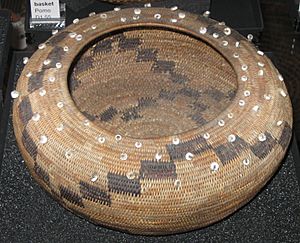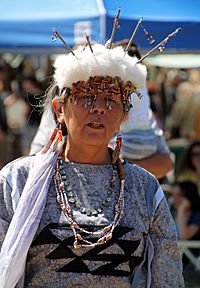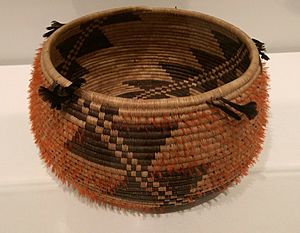Pomo facts for kids
|
Pomo woman in 2015
|
|
| Total population | |
|---|---|
| 1770: 8,000 1851: 3,500-5,000 1910: 777-1,200 1990: 4,900 2010: 10,308 |
|
| Regions with significant populations | |
| Languages | |
| Pomoan languages, English | |
| Religion | |
| Kuksu, Messiah Cult, traditional Pomo religion |
The Pomo are a group of Native American people who have lived in California for a very long time. Their traditional land was in northern California. It stretched from the Pacific Coast in the west, all the way inland to Clear Lake.
The name "Pomo" originally meant "those who live at red earth hole." This name came from a village in southern Potter Valley. It might have referred to red minerals like magnesite or reddish clay found there. These materials were used to make red beads or for other purposes. Over time, the name "Pomo" came to mean all the people known by that name today. The Pomo people were not ruled by one single leader. Instead, they had many chiefs at the same time.
Contents
Pomo Culture and Way of Life

The Pomo people were connected by where they lived, the languages they spoke, and their shared traditions. They did not act as one big, unified group. Instead, they lived in smaller groups, often called "bands." These bands were connected by family ties and marriages.
Traditionally, the Pomo people got their food by fishing, hunting, and gathering. They ate many different things like salmon, wild greens, mushrooms, berries, grasshoppers, rabbits, rats, and squirrels. Acorns were a very important food for them. Women usually gathered and prepared plant-based foods. Men were the hunters and fishers.
Pomo History and Traditions
The Pomo people are made up of several groups who speak related languages in Northern California. Their historic lands stretched from the Pacific Coast to Clear Lake. The Pomo preferred to live in small bands, connected by their location, families, and marriages. There were hundreds of these independent communities.
The Pomo culture is famous for its amazing basket weaving. They made very detailed baskets. Some special baskets even had bird feathers woven into them.
The Pomo also had important dances. The "Ghost Dance" was a ceremony where they honored those who had passed away. The "Far South" dance was a special event for children. It marked their passage into becoming a part of the tribe.
Pomo Languages
The Pomoan languages became very rare after Europeans came to their lands. Contact with Russian, Spanish, and English speakers affected these languages. Many Pomo people started speaking English instead. Today, about twelve Pomo language varieties are still spoken by Pomo people.
Pomo is a language family that includes seven different languages. These languages are so different that speakers of one cannot understand speakers of another. Some of these languages are Northern Pomo, Eastern Pomo, and Kashaya. The name "Pomo" was first used to describe this whole language family in 1877.
Images for kids
-
A Pomo person in a tule boat, around 1924.
-
Members of the Round Valley Indian Tribe remembering a forced move in 1863 to Covelo, California.
-
Doctor's Headdress (guk-tsu-shua), Pomo (Native American), from 1906–1907, at the Brooklyn Museum.
-
Girl's Coiled Dowry or Puberty Basket (kol-chu or ti-ri-bu-ku), from the late 1800s, at the Brooklyn Museum.
See also
 In Spanish: Pomo (etnia) para niños
In Spanish: Pomo (etnia) para niños











